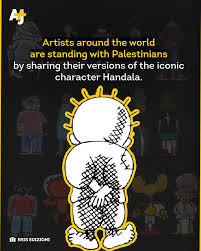
Introduction to Handala
Handala, the iconic character created by Palestinian cartoonist Naji al-Ali, stands as a potent symbol of resistance and resilience for the Palestinian people. First appearing in 1969, Handala depicts a 10-year-old boy dressed in tattered clothes and characterized by his distinctive posture—his back turned to the world. This imagery resonates deeply, portraying the struggles and aspirations of those living under occupation. The significance of Handala extends beyond a mere cartoon; it encapsulates the broader narrative of Palestinian identity and the enduring quest for justice.
Origins and Evolution
Naji al-Ali, born in Galilee in 1936, used his art to critique political developments in the Arab world and to highlight the plight of Palestinians, particularly after the Nakba in 1948. Handala was born from al-Ali’s own experiences of displacement and loss. The character has evolved over the decades, appearing in various forms and contexts, making his way from the cartoons of the 1970s into pop culture, art exhibitions, and social movements worldwide.
Handala in Contemporary Context
In recent months, the significance of Handala has become increasingly pronounced due to escalating tensions in the region. The ongoing conflict in Gaza and the West Bank has revived international attention on Palestinian rights, making Handala a relevant symbol for activism and solidarity. Activists often paint murals of Handala in protests and demonstrations, invoking his image as a rallying cry for justice and freedom. Social media also plays a crucial role in disseminating images and stories related to Handala, connecting a global audience to the Palestinian cause.
Art and Awareness
Handala’s image is not merely art; it is a powerful tool for awareness and education. Various organizations use Handala to engage with audiences, educating them about the history, culture, and current issues facing Palestinians. Art workshops and campaigns around Handala serve to bridge cultural gaps and foster dialogue about social justice. Events such as exhibitions showcasing works inspired by Handala have drawn the attention of human rights organizations and art enthusiasts alike, highlighting the potential of art to inspire change.
Conclusion: Significance of Handala
Handala, as a symbol, reflects the resilience of the Palestinian people and their ongoing struggle for rights and self-determination. His image serves as a reminder of the historical narratives often overlooked in mainstream discourse. As global awareness increases, the legacy of Handala continues to inspire new generations to advocate for justice. The importance of this character transcends borders, calling for solidarity with those facing oppression. As events unfold in the region, the figure of Handala remains central to the conversation about peace and justice, urging the world to remember and act upon the plight of Palestinians today.



